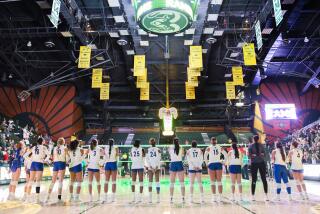More Walk-Ons May Keep Men’s Teams Running
- Share via
Some might consider Dan Hicks, the wrestling coach at Cal State Fullerton, a Title IX victim.
He coaches the team without an assistant. His program is limited to three scholarships. And the school caps his roster at 30 wrestlers because women account for about 60% of the student body at Fullerton, and Title IX compliance is achieved by making the proportion of male and female athletes reflect the enrollment.
Operating on a shoestring budget has its downsides. When Fullerton held an open wrestling tournament in November, about 15 Titans who were not part of the team’s 10-man lineup had to come up with the $20 entry fee out of their own pockets.
Hicks, though, was optimistic about the future of his program after learning that a national commission recommended Thursday that walk-ons -- athletes not on scholarship -- not be counted as part of a school’s male total.
“Walk-ons are the main issue for us,” Hicks said. “I don’t want to have them tell us to cap it at 30 [wrestlers].”
Between 1982 and 2001, 138 colleges dropped wrestling programs, largely, coaches say, because of the implementation of Title IX, the federal law requiring gender equity in college athletics.
A lawsuit filed by the National Wrestling Coaches Assn., claiming that the proportionality aspect of Title IX has evolved into a quota system, prompted the Bush administration to form an advisory commission that studied the law.
The panel’s recommendation to not count male walk-ons could have an impact on men’s sports that have been hamstrung by roster restrictions.
Hicks said a larger roster would allow for more productive practices and help Fullerton’s wrestling team become more competitive.
“So many kids that are in wrestling would love to walk on,” said Hicks, who was hired in July. “I could have 50 guys, working out and wrestling.”
Hicks said he spreads the team’s three scholarships -- the NCAA maximum for wrestling is 9.9 scholarships -- among about 12 wrestlers. Walk-ons receive a shirt and shorts, and must pay their own way if they choose to compete in open tournaments.
Fullerton (8-9, 3-4 in the Pacific 10 Conference) is the only NCAA Division I wrestling program in the state south of Cal State Bakersfield.
“There are a ton of kids in Southern California who wrestle, but a lot of them have had to go to college out of state,” Hicks said. “If we were able to offer more opportunities here, kids wouldn’t have to leave.”


